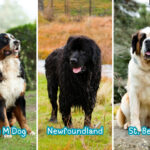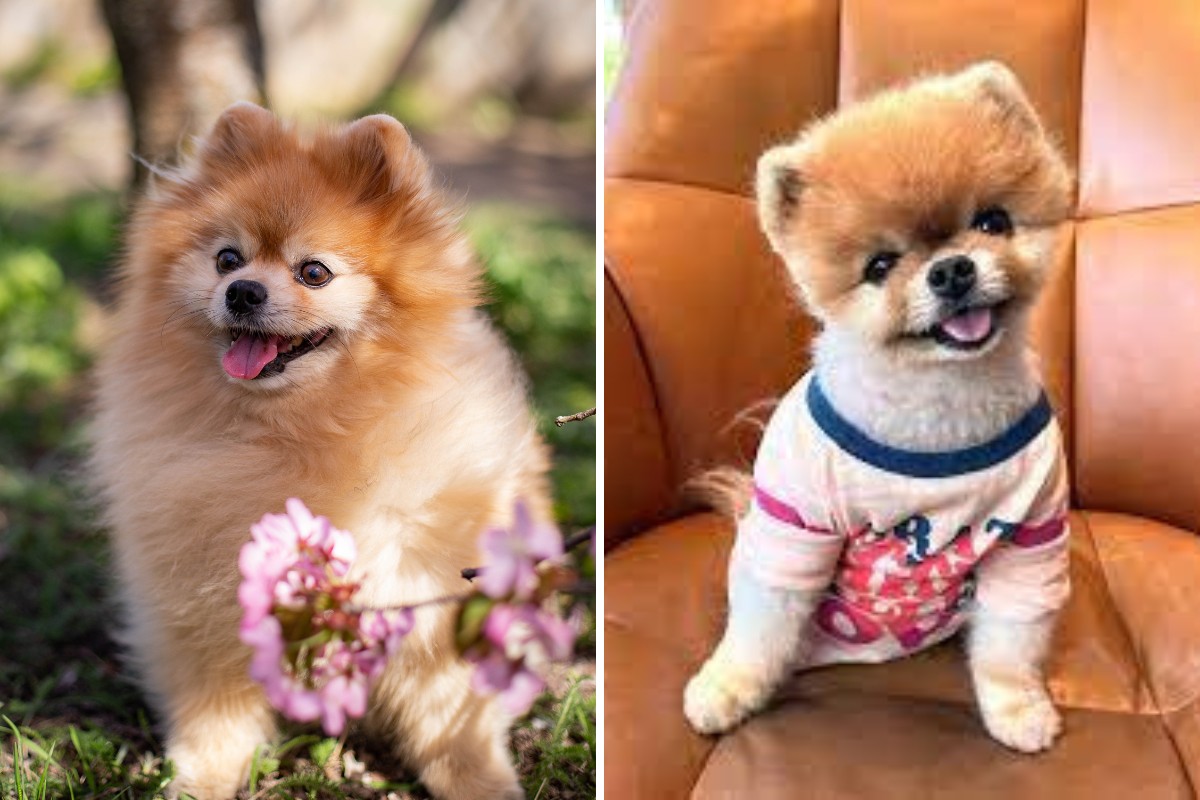 9 Nov
9 Nov9 Amazing Facts About Pomeranians
For the love of Pomeranians, we will be shining the spotlight on one of the most enchanting breeds that has captured hearts all around the globe.
These pint-sized pups aren’t just a bundle of fluff; they carry a charisma that outshines their compact stature. Whether you’re a seasoned Pomeranian parent or simply curious about these vivacious little dogs, there’s always something new to learn.
Pomeranians, with their luxurious coats and alert, animated expressions, are the epitome of canine charm. They might be small enough to fit in the crook of your arm, but their personalities are large enough to fill a room.
As we explore nine amazing facts about Pomeranians, you’ll get a glimpse into the rich tapestry that makes up their storied past, the surprising variety within the breed, and the unique quirks that Pomeranian lovers know and cherish.
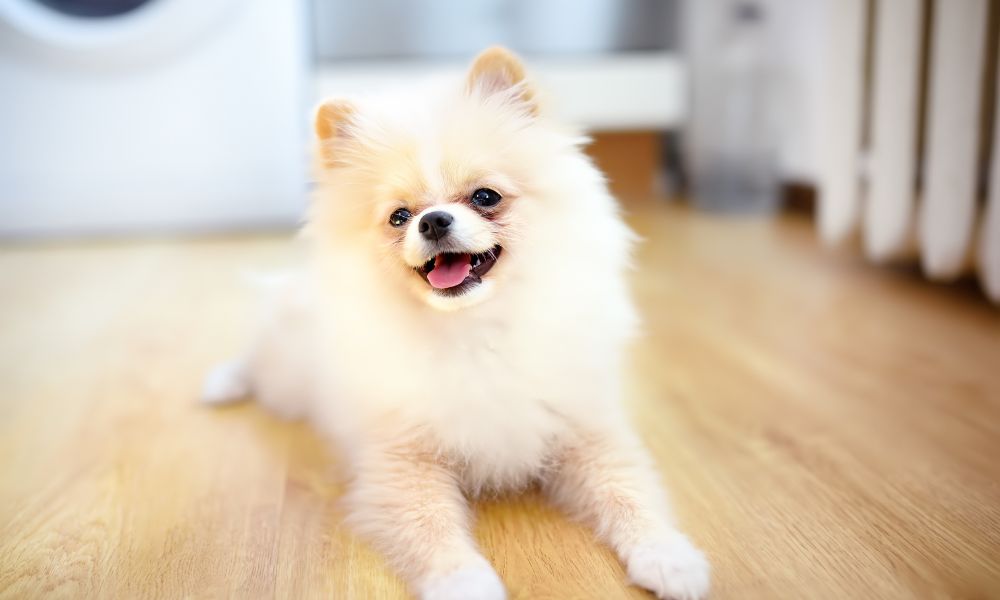
Fact #1. The Royal History of Pomeranians
The Pomeranian breed boasts an illustrious history that intertwines with the very fabric of European royalty. These plush-coated canines weren’t always the petite lapdogs we dote on today. Originally, they were larger, robust dogs bred to herd animals and pull sleds in Pomerania, now part of modern-day Poland and Germany.
But it wasn’t long before their intelligence and elegance caught the eyes of nobility. In the royal courts of Europe, Pomeranians transitioned from their working-dog roots to become symbols of status and luxury.
They lounged in the aristocracy’s lavish palaces and manicured gardens, becoming as much a part of courtly life as opulent attire and grandiose titles. One of the most notable royal Pomeranian enthusiasts was Queen Victoria of England. Her affection for the breed was no fleeting fancy; it had a lasting impact on Pomeranians.
Queen Victoria’s preference for smaller Poms often influenced the breed to become the petite pups we’re familiar with today. Her own Pomeranian, Marco, was particularly famous and is credited with influencing the breed’s smaller size over time.
These historic Pomeranians weren’t just pampered pets; they were also diplomatic gifts between states, signifying peace and alliances, and they were featured prominently in portraits that communicated wealth and sophistication.
Fact #2. Pomeranians and Their Famous Owners Throughout History
The allure of Pomeranians has captivated many throughout history, extending beyond the royal lineage to include a roster of famed individuals who have shared their lives with these charming canines. These historical figures weren’t just passive admirers; their Pomeranians often became as much a part of their legacy as their achievements.
Wolfgang Amadeus Mozart, the prodigious composer, shared his home and heart with a Pomeranian named Pimperl, to whom he even dedicated an aria. This affectionate nod is a testament to the deep bond that can form between humans and their Pom companions.
Moving forward to more contemporary times, the Pomeranian’s star-studded appeal continues. They grace the social media pages of today’s celebrities, accompanying them on set, during shopping excursions, and even down the red carpet, showcasing the enduring appeal of these photogenic pooches.
The influence of these modern-day celebrity Pomeranian owners is substantial. When a famous face posts a photo with their fluffy companion, it’s not just a personal update; it’s a cultural moment that can spark trends in dog fashion, raise awareness for animal rights, or even cause a surge in breed popularity. The visibility that comes with celebrity endorsement has a real-time effect on public perception and the desirability of the breed.
Moreover, celebrities who advocate for rescue and adoption help to shine a light on Pomeranians in shelters in need of a loving home. This powerful message resonates with their fans and the broader public, reinforcing the idea that the companionship of a Pomeranian is not exclusive to the rich and famous but a joy that can be shared by anyone.
Fact #3. The Unique Vocal Abilities of Pomeranians
Pomeranians may be small in size, but their vocal presence can fill any room—a trait that Pomeranian owners know all too well. These charismatic little dogs possess a robust, distinctive bark that is much more sonorous than one might expect from such a petite frame.
Pomeranians’ vocalizations are not just loud but nuanced, with a range that can signal anything from sheer excitement to an assertive warning. Their bark is textured with various pitches, and attentive owners can learn to decipher what their Pomeranian might be trying to communicate.
For instance, a high-pitched, sharp bark often means the dog is alerting you to something new or unusual in its environment. It’s their way of saying, “Hey, pay attention to this!” On the other hand, a more rhythmic, playful bark is the dog’s unique way of initiating play or expressing the joy of your company.
Pomeranians are known to be very expressive, not only with their barks but with other sounds too. They can whine or whimper when they seek attention or are in distress. Some Poms may also use a low grumble or mutter to themselves when they’re content or pondering the great mysteries of the living room. Yes, Pomeranians can be quite the canine philosophers at times!
Understanding these communication habits is vital for any Pomeranian owner. It can help in addressing their needs, strengthening your bond, and even in training.
Training a Pomeranian to use their ‘inside voice’ can be a rewarding experience that tempers their instinct to announce every leaf that falls in the backyard. Positive reinforcement techniques work wonders here, rewarding them for quieter behavior and gently discouraging excessive vocalization.
Moreover, these vocal abilities can serve as an early warning system. Pomeranians are often excellent watchdogs, not because they can physically challenge an intruder, but because they can alert their owners to unusual activity with their surprisingly powerful bark.
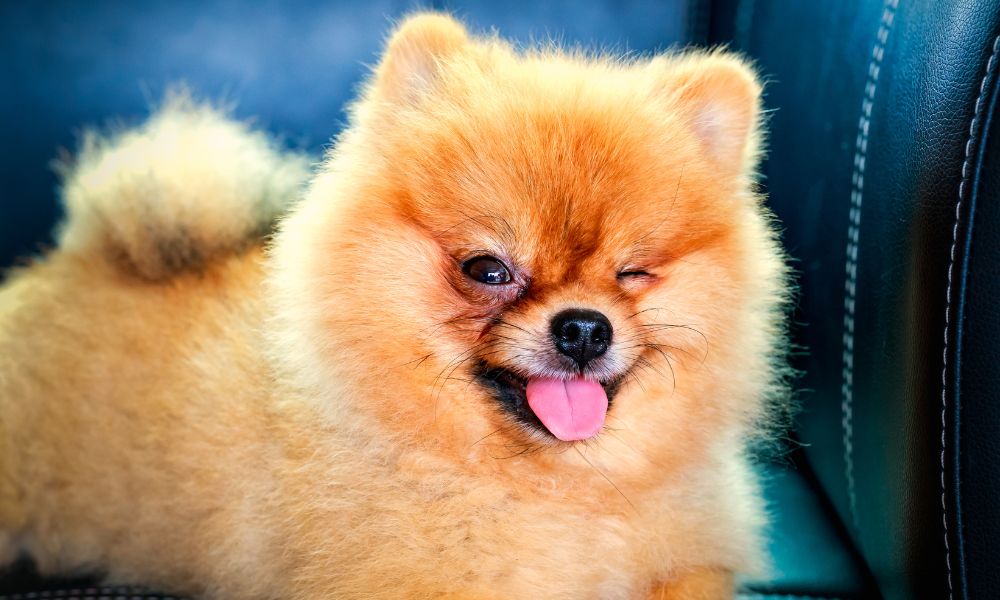
Fact #4. Pomeranians: A Whole Palette of Colors
The Pomeranian breed is like a walking rainbow of fluff, offering a stunning variety of coat colors that are sure to appeal to any preference. These colors range from the classic oranges and reds to the less common blues and lavenders. The array of Pomeranian colors is one of the breed’s most visually striking attributes, allowing each dog to possess its own unique flair.
The most commonly recognized Pomeranian coat color is a bright, vibrant orange. However, Pomeranians are not limited to this signature hue. Their coats can also be found in other solid colors such as black, chocolate, cream, blue, and pure white. Beyond solids, there are also a number of multi-colored Poms, including black and tan, parti-color (which can be a mix of any color with white), and merle patterns, known for their mottled patches of color.
The diversity in the Pomeranian’s coat color is the result of complex genetics. Each Pomeranian puppy’s fur color is determined by the combination of genes received from its parents. These genes carry instructions for the production of pigments that give the fur its color. The two main pigments are eumelanin (black pigment) and phaeomelanin (red pigment), and the variations in these pigments and their distribution lead to the wide spectrum of colors seen in Pomeranians.
For instance, a gene called the ‘dilution gene’ can change a black Pomeranian into a blue or lavender, diluting the strong black pigment to a softer grayish tone. Similarly, the ‘Merle gene’ creates a beautiful pattern of dark blotches against a lighter background and can affect all colors, adding to the breed’s rich tapestry of coat variations.
It’s also fascinating that Pomeranian puppies can change colors as they grow. A Pom that starts out as a dark black may become a much lighter blue or even a completely different color as it matures. This is because the fur’s pigmentation can be influenced by factors like age, health, and environmental conditions.
When considering a Pomeranian, it’s important to note that the breed standard recognizes all colors, patterns, and variations. There is no “rare” color in Pomeranians, and coat color does not affect a Pomeranian’s personality or health.
Fact #5. Pomeranians in Pop Culture
Pomeranians hold a special place not just in the homes of their owners, but also in the glittering world of pop culture. With their expressive faces and buoyant personalities, these dogs have trotted their way into the spotlight of various media platforms, influencing fashion trends and becoming icons in their own right.
One cannot discuss Pomeranians in pop culture without mentioning ‘Boo,’ the Internet sensation dubbed “The World’s Cutest Dog.” With his teddy bear-like appearance and a massive following on social media, Boo brought Pomeranians into the digital limelight, influencing pet fashion trends and even leading to his own line of toys.
Television has also seen its fair share of Pomeranian cameos. The sitcom “Parks and Recreation” featured a Pomeranian as “Andy,” the three-legged wonder dog. The breed’s appearance on such shows often sparks conversations and online searches, momentarily boosting their pop culture status.
Fashion is another arena where Pomeranians have made their mark. Luxury brands have featured Pomeranians in advertisements and runway shows, sometimes dyed in fantastical colors, which although controversial, speaks to the breed’s show-stopping appeal. In the arms of models and celebrities, Pomeranians have become living accessories, strutting down boulevards as much as fashion runways.
Pomeranians also influence the world of art and design, with their likenesses gracing everything from high-end t-shirts and handbags to custom artwork and home decor. Their distinctive look inspires designers and artists to create items that capture the breed’s unique blend of elegance and spunk.
The breed’s influence extends to festivals and events, such as Pomeranian meet-ups and specialty shows, further cementing their status as cultural fixtures. Pomeranian owners gather in numbers, sharing their experiences and showing off the latest in canine couture.
Fact #6. Record-Breaking Pomeranians
Pomeranians may be small in stature, but they stand tall when it comes to making their mark in the Guinness Book of World Records. Their sprightly spirits and endearing characters have seen them achieve some remarkable feats that earn them a place in the record books.
One of the most famous record-holding Pomeranians is Jiffpom, a canine celebrity with his own social media empire. He rocketed to fame and into the Guinness Book of World Records not once but twice. First, he claimed the title of the fastest dog on two paws, both on his hind legs and front legs.
Jiffpom’s speed on his hind legs covered 10 meters in 6.56 seconds, and on his front paws, he dashed 5 meters in 7.76 seconds—an impressive feat that showcases the agility and training of this particular Pom.
Pomeranians have also made their mark in terms of longevity. With their lifespan typically ranging from 12 to 16 years, it’s not uncommon to hear of Pomeranians surpassing this average.
Although specific records of the oldest Pomeranians have not been officially recorded in the Guinness World Records, there are many instances of Pomeranians living into their late teens and even early twenties, given the proper care and genetic luck.
Additionally, while not all are officially recognized by Guinness, Pomeranians have achieved records in canine sports and competitions. For example, in agility trials, Pomeranians have proven that they can navigate obstacle courses with the dexterity and determination of dogs many times their size.
These record-breaking dogs do more than just perform impressive feats; they bring attention to the capabilities of small breeds. They serve as ambassadors, showing that Pomeranians, despite their toy breed classification, have remarkable talents that can rival those of any other breed.
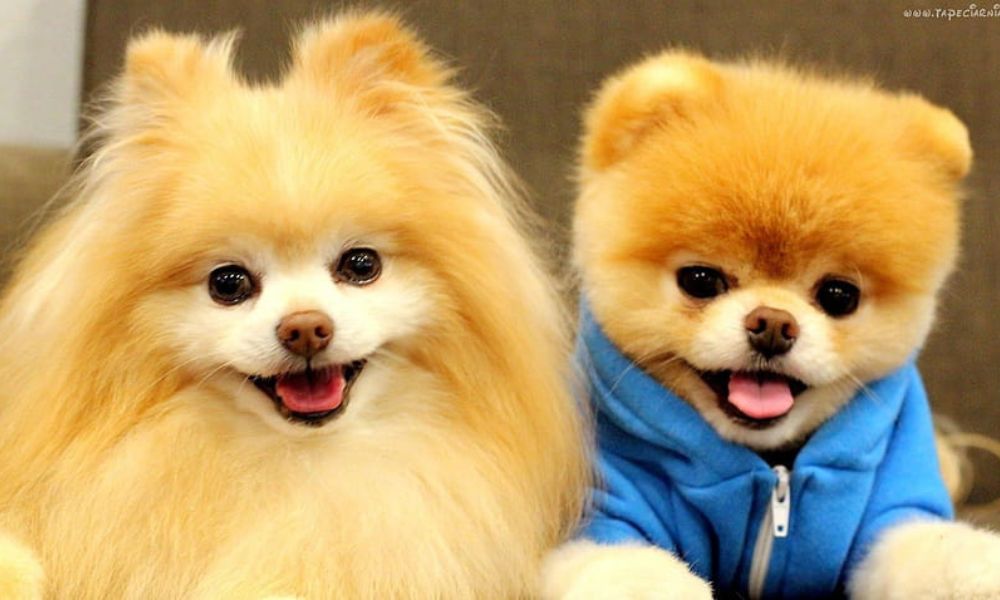
Fact #7. The Longevity and Health of Pomeranians
Pomeranians, with their fluffy coats and bright eyes, are not just bundles of energy and charisma; they’re also a breed that, with proper care, can enjoy a long and healthy life. Typically, a Pomeranian’s life expectancy ranges from 12 to 16 years, although some can live even longer with the right combination of genetics, diet, and healthcare.
Despite their robustness, Pomeranians, like all breeds, are prone to certain health concerns. Being aware of these can help owners prevent or manage potential issues more effectively.
Some common health challenges that Pomeranians may face include dental issues due to their small mouths, which can lead to tooth crowding and an increased risk of periodontal disease. Keeping up with regular dental check-ups and cleanings can significantly help maintain their overall health.
Luxating patella, a condition where the kneecap moves out of place, is another concern within the breed, as are certain heart conditions such as patent ductus arteriosus and collapsed trachea, which can lead to coughing or difficulty breathing. Early detection and treatment are crucial for managing these conditions.
Pomeranians can also be susceptible to skin issues, including alopecia, or hair loss, which can be caused by various factors including genetics, allergies, or parasites. Regular grooming and veterinary check-ups can help to identify and treat any skin conditions before they become more serious.
To support the health and longevity of a Pomeranian, it’s important to maintain a healthy lifestyle. A balanced diet tailored to their specific life stage and energy levels is essential. High-quality dog food that meets the nutritional needs of small breeds can promote a healthy weight and overall wellness.
Regular exercise is equally important. Despite their small size, Pomeranians have a lot of energy to burn. Daily walks and play sessions can help keep them fit and prevent obesity, which is particularly important for maintaining joint health.
Mental stimulation is also a key component of a healthy lifestyle for Pomeranians. They are intelligent dogs that enjoy learning and being challenged. Puzzle toys, training sessions, and games can help keep their minds sharp and stave off boredom.
Regular veterinary care, with annual check-ups and vaccinations, is another pillar of maintaining a Pomeranian’s health. These visits allow for early detection of any potential health issues and provide an opportunity for preventive care.
Fact #8. The Pomeranian’s Surprisingly Large Ancestry
Pomeranians, the vivacious and fluffy companions that we know today, have a lineage that might come as a surprise to many. They descend from a lineage of robust, powerful working dogs of the Arctic – the Spitz breeds, known for their resilience and ability to thrive in cold climates. This remarkable evolution from sled-pulling canines to pampered lapdogs is a fascinating journey through canine history.
Relationship to the Larger Spitz Breed
Spitz-type dogs are characterized by their long, thick fur, pointed ears, and fox-like faces – traits that are prominently visible in Pomeranians. Historically, these dogs were bred for hard work in the Arctic regions, serving as sled dogs, livestock herders, and guardians. Breeds in the Spitz family include the Alaskan Malamute, the Samoyed, and the Norwegian Elkhound, among others.
Pomeranians originally were much larger, closer to the size of their Spitz ancestors, weighing in at around 30 pounds, which is roughly three times the size of today’s Pomeranians. They share the same robust genetic background, which is why, despite their diminutive stature, Pomeranians are often fearless and bold, with a strong sense of self.
Evolution of the Breed from Sled Dogs to Lapdogs
The transformation of Pomeranians from sled-pulling Spitz dogs to the small lapdogs we are familiar with began in the region of Pomerania, now part of modern-day Poland and Germany. Through selective breeding, Pomeranians were gradually bred down in size while retaining their Spitz characteristics and temperament.
The breed became particularly popular when Queen Victoria of England took a liking to a smaller-sized Pomeranian, which she saw during a trip to Italy. She began breeding them to be even smaller, and due to her influence as a monarch, the trend of owning small Pomeranians spread across Europe.
The shift from working dogs to companion animals also came with a change in breeding priorities. Instead of endurance and strength, breeders began to select for qualities like companionship, temperament, and appearance.
Over time, Pomeranians became the toy breed we know today, celebrated for their extroverted personalities and decorative, plush coats, which serve them more as fashion statements than as protection against the Arctic cold.
The transition from a sled dog to a lapdog also reflects changes in society and human lifestyles. As people moved from rural areas to cities during the Industrial Revolution, smaller dogs who could live comfortably in smaller spaces became more desirable.
Fact #9. Pomeranian Grooming and Care
Grooming a Pomeranian is not just about maintaining their stunning appearance; it’s an essential part of their overall health and social well-being.
Due to their thick double coats, Pomeranians require a consistent grooming routine to look and feel their best. Here’s what Pomeranian owners need to know to provide the best care for their furry friends.
Essential Grooming Tips for Pomeranian Owners
Brushing: Regular brushing is the cornerstone of Pomeranian grooming. Aim to brush your Pom’s coat several times a week to prevent matting and to distribute natural oils throughout their fur. Using a proper brush, such as a pin brush or a slicker brush, can help to detangle the topcoat and undercoat without causing discomfort.
- Bathing: Bathing a Pomeranian every 3 to 6 weeks can help maintain their coat’s cleanliness without stripping it of natural oils. Always use a dog-specific shampoo that caters to their skin’s pH levels and follow with a conditioner to keep their fur soft and manageable.
- Drying: After a bath, it’s important to dry a Pomeranian thoroughly. Due to their dense fur, leaving the coat damp can lead to skin irritation or infections. A low-heat blow dryer can speed up the process and fluff up their coat nicely.
- Ear Care: Poms can accumulate wax and debris in their ears, which can lead to infections. Regular checks and gentle cleaning with a suitable canine ear cleaner are recommended.
- Nail Trimming: Overgrown nails can cause discomfort or even affect a Pomeranian’s gait and posture. Keeping their nails trimmed to a comfortable length is essential.
- Dental Hygiene: Dental care is crucial due to their predisposition to dental issues. Regular brushing with dog-safe toothpaste and chew toys can help keep their teeth clean and gums healthy.
- Eye Care: Pomeranians can be prone to tear staining. Gently wiping the area around their eyes with a soft, damp cloth can prevent staining and keep their eyes clear.
The Importance of Grooming for Pomeranian Health and Social Life
Grooming is about more than just making sure your Pomeranian looks good—it has significant health implications. For example, brushing not only prevents painful mats but also stimulates the skin and improves blood circulation. Moreover, it allows for the early detection of any skin issues or parasites.
Bathing and grooming are also an opportunity to check for any bumps, lumps, or signs of health issues that might otherwise go unnoticed. This proactive aspect of grooming can mean the difference between early treatment and a more serious condition developing.
Additionally, a well-groomed Pomeranian is more likely to be a social butterfly. Regular grooming keeps them smelling fresh and looking approachable, which can impact how both humans and other dogs interact with them. Social interactions are vital for the behavioral development and mental health of any dog, and Pomeranians are no exception.
Finally, the routine of grooming establishes a bond between you and your Pom. It’s an act of care that reinforces trust and can help in establishing a well-rounded, affectionate, and sociable pet. The one-on-one time spent during grooming sessions provides an opportunity for positive interactions and comfort, which can be especially soothing for anxious dogs.


